
#1: Removed from shell - this one came out completely.
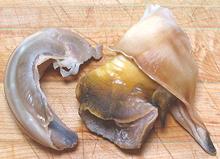
#2: Mushy part pulled loose from firm edible part.
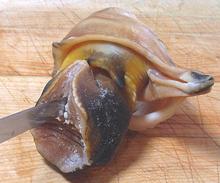
#3: Inserting the knife into the false mouth.
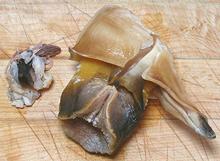
#4: The foregut has been split and cleaned out.
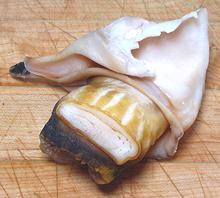
#5 Recipe Ready. This is the other side. The white area is the
scar from where the operculum was.
Buying:
The photo specimens were purchased at a large Asian market in Los Angeles (San Gabriel) for 2016 US $3.99 /p pound. They are usually labeled "Conch", which they are not. This is not a snail that's normally in stock, it's strictly a "buy it when you see it" item.Yield:
Three whelks weighing 4 pound 13 ounces yielded 16 ounces of edible flesh (21%). At $3.99 per pound, that comes to $19.18 per pound of edible flesh.Cleaning:
These whelks are cleaned about the same as other whelks, differing mainly in size - these are usually quite a bit larger.- Let your whelks relax for a while, then check them to make sure they're alive. If you poke them they should respond by pulling tighter into their shells. Discard any dead ones (unless you know they just died) and scrub the live ones under cold running water with a stiff brush to remove extraneous muck and miscellaneous sea life.
- Let the whelks relax while you boil up a big pot of salted water, then toss them in and bring it back up to a boil as quickly as possible. Once it's back to a boil let them cook for 15 to 20 minutes, depending on size.
- Cool the whelks in cold water until you can handle them easily. A salad fork is an excellent tool to pry the snail out far enough so you can get a firm grip on it. Once you have a good grip, pull it out as if unwinding it from its shell. If you are lucky the whole thing will come out in one piece. Otherwise, some of the inedible part may remain in the shell. The operculum (the hard door that closes the shell) will probably be knocked off. Photo #1 shows the complete contents of the shell.
- Pull off the gooky inedible part as shown in Photo #2. It should come off intact, leaving little on the edible part. Under cold running water wash out any gooky stuff. Rubbery stuff is all edible, including siphons and the thin mantle, but gooky parts are not.
- Clean out between the body and the mantle. There are gills in there, similar to fish gills but without the prickly gill rakers, and some other stuff.
- Find the whelk's false mouth. It's right between two short tentacles. and just above the foot, as in Photo #3. Now insert your filleting knife into the false mouth, sharp edge up, and split the foregut all the way back as shown in Photo #4. Clean everything out, which will include the real mouth and it's rasp-like radula, at the end of the extensible proboscis.
- You should now have a nice clean and edible hunk of whelk, as shown in Photo #5. You can use it now, or freeze for later.
Note: if everything didn't pull out of the shell but you want to keep the shell, that stuff won't come out easily, and it will be smelly for a while. If you can find a convenient ant hill, place the shells near it and let the ants clean it out.
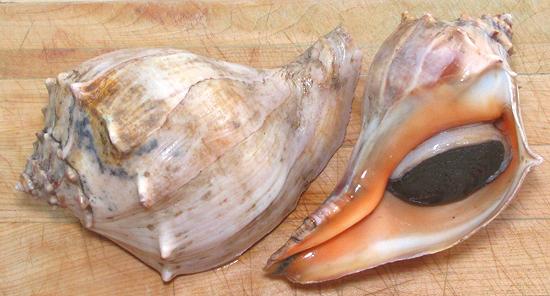 [Busycon carica]
[Busycon carica]